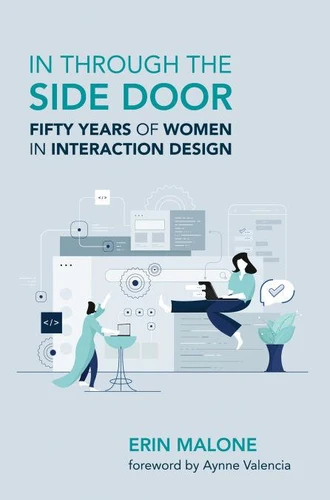In through the Side Door. Fifty Years of Women in Interaction Design
Par : ,Formats :
Disponible dans votre compte client Decitre ou Furet du Nord dès validation de votre commande. Le format ePub protégé est :
- Compatible avec une lecture sur My Vivlio (smartphone, tablette, ordinateur)
- Compatible avec une lecture sur liseuses Vivlio
- Pour les liseuses autres que Vivlio, vous devez utiliser le logiciel Adobe Digital Edition. Non compatible avec la lecture sur les liseuses Kindle, Remarkable et Sony
- Non compatible avec un achat hors France métropolitaine
 , qui est-ce ?
, qui est-ce ?Notre partenaire de plateforme de lecture numérique où vous retrouverez l'ensemble de vos ebooks gratuitement
Pour en savoir plus sur nos ebooks, consultez notre aide en ligne ici
- Nombre de pages390
- FormatePub
- ISBN978-0-262-37945-8
- EAN9780262379458
- Date de parution15/10/2024
- Protection num.Adobe DRM
- Taille52 Mo
- Infos supplémentairesepub
- ÉditeurThe MIT Press
Résumé
The vital story of how women designers and researchers pioneered the field of interaction and user experience design for software and digital interfaces. Framed against the backdrop of contemporary waves of feminism and the history of computing design, In through the Side Door foregrounds the stories of the women working in the field of computing and the emergent discipline of interaction design as the graphical user interface was developed.
Erin Malone begins with a handful of pioneers who brought to the field various methods from a variety of backgrounds including design, technical communication, social psychology, ethnography, information science, and mechanical engineering. Moving into the early days of desktop computing, the book highlights the women on the teams inventing contemporary desktop computer interfaces and related tools, including those at Xerox PARC, Apple's Human Interface Group, and Microsoft.
Malone takes the reader through the invention of the World Wide Web, the third wave of feminism, and the dot-com boom and bust. Coming up to contemporary times, the book features women working on the web, designing equipment interfaces, and working in voice UX, mobile design, and civic design, and continues with the up-and-coming leaders driving social impact, changing human-centered design and research, and working to be accountable for the harms of contemporary software products.
Along the way, the author also touches on the challenges and biases women have faced in the workplace and continue to encounter despite cultural and sociological advancements.
Erin Malone begins with a handful of pioneers who brought to the field various methods from a variety of backgrounds including design, technical communication, social psychology, ethnography, information science, and mechanical engineering. Moving into the early days of desktop computing, the book highlights the women on the teams inventing contemporary desktop computer interfaces and related tools, including those at Xerox PARC, Apple's Human Interface Group, and Microsoft.
Malone takes the reader through the invention of the World Wide Web, the third wave of feminism, and the dot-com boom and bust. Coming up to contemporary times, the book features women working on the web, designing equipment interfaces, and working in voice UX, mobile design, and civic design, and continues with the up-and-coming leaders driving social impact, changing human-centered design and research, and working to be accountable for the harms of contemporary software products.
Along the way, the author also touches on the challenges and biases women have faced in the workplace and continue to encounter despite cultural and sociological advancements.
The vital story of how women designers and researchers pioneered the field of interaction and user experience design for software and digital interfaces. Framed against the backdrop of contemporary waves of feminism and the history of computing design, In through the Side Door foregrounds the stories of the women working in the field of computing and the emergent discipline of interaction design as the graphical user interface was developed.
Erin Malone begins with a handful of pioneers who brought to the field various methods from a variety of backgrounds including design, technical communication, social psychology, ethnography, information science, and mechanical engineering. Moving into the early days of desktop computing, the book highlights the women on the teams inventing contemporary desktop computer interfaces and related tools, including those at Xerox PARC, Apple's Human Interface Group, and Microsoft.
Malone takes the reader through the invention of the World Wide Web, the third wave of feminism, and the dot-com boom and bust. Coming up to contemporary times, the book features women working on the web, designing equipment interfaces, and working in voice UX, mobile design, and civic design, and continues with the up-and-coming leaders driving social impact, changing human-centered design and research, and working to be accountable for the harms of contemporary software products.
Along the way, the author also touches on the challenges and biases women have faced in the workplace and continue to encounter despite cultural and sociological advancements.
Erin Malone begins with a handful of pioneers who brought to the field various methods from a variety of backgrounds including design, technical communication, social psychology, ethnography, information science, and mechanical engineering. Moving into the early days of desktop computing, the book highlights the women on the teams inventing contemporary desktop computer interfaces and related tools, including those at Xerox PARC, Apple's Human Interface Group, and Microsoft.
Malone takes the reader through the invention of the World Wide Web, the third wave of feminism, and the dot-com boom and bust. Coming up to contemporary times, the book features women working on the web, designing equipment interfaces, and working in voice UX, mobile design, and civic design, and continues with the up-and-coming leaders driving social impact, changing human-centered design and research, and working to be accountable for the harms of contemporary software products.
Along the way, the author also touches on the challenges and biases women have faced in the workplace and continue to encounter despite cultural and sociological advancements.



